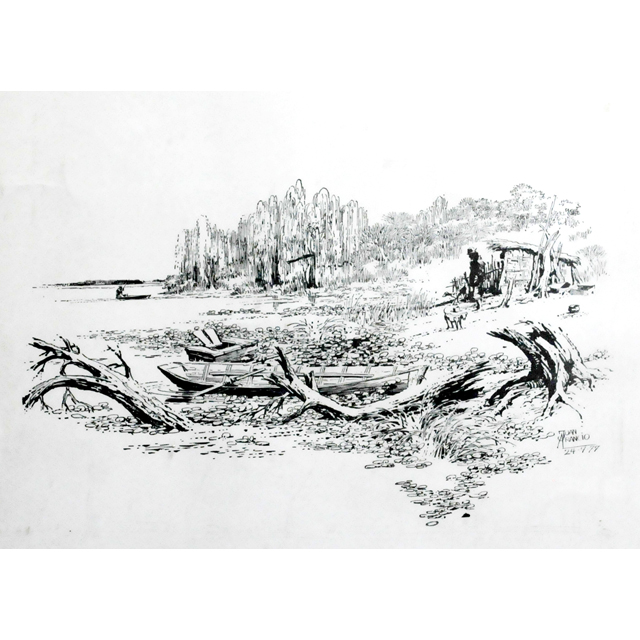
Juan Arancio
Serigrafia, 50 x 60 cm
(1974)
Arancio nos presenta una escena cotidiana de ribera, donde una tapera muy pobre y de apariencia muy frágil sirve de refugio probablemente a una familia de pescadores. Una figura que bien podría ser un pescador sale presto a preparar sus enseres de trabajo (en rigor, vemos en primer plano la barcaza sobre la orilla), algunos animales domésticos lo acompañan y, al fondo, pequeño, otro botecito con otro pescador parece volver. La flora propia de la zona, como los sauces o las plantas acuáticas de la orilla, son indicios de que probablemente sea ésta una escena captada en la zona de afluentes del Paraná, o del Delta. Esta precisión para los detalles descriptivos es equilibrada, como dijéramos más arriba, por omisiones precisas y calculadas. El agua no es en ningún momento ni siquiera esbozada. Su sola existencia es sugerida por el artista y deducida por el espectador gracias a elementos muy puntuales y efectivos: podemos ver que cuando el bote diminuto del fondo se acerca lentamente a la orilla no se perturba la superficie del agua, y por ello no es representada más que como sostén de esta embarcación. Es decir, sabemos que está allí solamente por el bote. Lo mismo ocurre con la orilla del río en el plano más cercano a nosotros. Las plantas acuáticas crecen en la zona menos profunda y proliferan, pero en cierto punto se detiene su crecimiento y allí es donde percibimos la masa de agua. Casi como en una pintura oriental, los llenos son compensados y equilibrados por los vacíos, y el elemento protagonista de la obra, en este caso el agua, es definido por lo que no es. Otro recurso que utiliza es el grafismo. Al Análisis de obra trabajar la serigrafía linealmente, como si se tratara de un trabajo a la tinta con pluma, las sombras y luces son contrastadas gracias a múltiples tramas; el follaje de los árboles y la vegetación acuática son distintos grafismos gestuales que aportan dinamismo y anclaje mimético a la composición. Todo funciona como una ilustración, el momento plástico y estético de la obra está sujeto a un momento narrativo. La cualidad lineal de toda la obra, la fuerte tendencia gráfica del lenguaje utilizado es funcional a esta relación estético-narrativa propia de la ilustración. Espacios que se definen por su propia ausencia, detalles minuciosos en algunas zonas, deliberadas omisiones en otras, todo hace de esta obra una espacio sumamente interesante, límpido y estudiado.
Juan Arancio
Serigraphy, 50 x 60 cm
(1974)
Arancio presents us an everyday riverside scene, where a very poor and fragile-looking tapera (a precarious housing) probably serves as shelter for a family of fishermen. A figure that could be a fisherman comes out ready to prepare his work equipment (we can see the barge on the shore in the foreground), some domestic animals accompany him and, in the background, another small boat with another fisherman seems to return. The floral typical of the area, such as the willows or the aquatic plants on the shore, are indications that this is probably a scene capured in the area of tributaries of the Paraná river or the Delta. This precision for descriptive details is balanced, as we said above, by precise and calculated omissions. The water is not sketched at any time. Its very existence is suggested by the artist and deduced by the viewer thanks to very specific and effective elements: we can see that when the tiny boat in the background slowly approaches the shore, the surface of the water is not disturbed, and therefore it is not represented more than as a support for this boat. That is, we know it is only there because of the boat. The same thing happens with the river bank in the plane closest to us. Aquatic plants grow in the shallowest area and proliferate, but at a certain point their growth stops and that is where we perceive the mass of water. Almost as in an oriental painting, the fills are compensated and balanced by the voids, and the protagonist element of the work, in the case the water, is defined by what it is not there. Another resource that he uses is graphics. When analyzing the work, the artist works the silkscreen linearly, as if it were an ink work with a pen, the shadows and lights are contrasted thanks to multiple plots; the foliage of the trees and the aquatic vegetation are different gestual graphics that provide dynamism and mimetic anchoring to the composition. Everything works as an illustration, the plastic and aesthetic moment of the work is subject of the entire work, the strong graphic tendency of the language used is functional to this aesthetic-narrative relationship typical of illustration. Spaces that are defined by their own absence, specific details in some areas and deliberate omissions in others, everything makes this work an extremely interesting, limpid and studied space.